4K is the new standard, and the best 4K cameras for shooting video will be able to record at this resolution quality in a variety of frame rates. In particular, cameras that record 4K at 60p and 4K at 120p are highly sought after. Ever since the Nikon D90 introduced video to interchangeable lens cameras back in 2008, the video mode has become an increasingly important feature for photographers. And these days, every new flagship camera on down to most phones and compact cameras will boast of its 4K video chops.
With clients asking for more video, a camera’s video capabilities can no longer be ignored. Once derided, the video mode has quickly become one of the primary specs by which photographers judge a camera. Over the last couple years the once-revolutionary HD video standard has been swept aside by the rise of cameras capable of producing footage in 4K resolution.
Here we’ve rounded up what we believe are the best 4K cameras on the market for shooting high resolution video. A quick note before we get started: we’ve ignored professional, dedicated video cameras like the Canon Cinema EOS or Sony FS series in this list of the best 4K cameras. We’re focusing solely on the best 4K cameras for those photographers crossing over into video or who may find themselves being asked to shoot more video footage for clients.
But first, let’s delve a little deeper into what 4K resolution means.
What is 4K resolution?
One frame of 4K video is comprised of 3,840 x 2,160 pixels. What 4K means is a new resolution standard that offers four times the resolution quality as Full HD.
There are actually several different 4K resolutions that are recognised, but the two most widely used formats are Ultra HD (3,840 x 2,160 pixels) and Cinema 4K (4,096 x 2,160, also known as DCI 4K).
Ultra HD is probably the more commonly found format because it uses the same 16:9 aspect ratio of most televisions these days.
What is 4K UHD vs Cinema 4K video?
This is a common question not just for new videographers, but anyone new to 4K video recording. What most people call ‘4K video’ is really 4K UHD, which is 3840 x 2160 pixels in resolution and records in a 16:9 aspect ratio. This is what you find on most 4K cameras.
Cinema 4K offers a 4096 x 2160 resolution in a 17:9 aspect ratio. It’s a slight difference, but an important one.
What 4K means for photographers
Because 4K video is so high resolution, one frame can produce an 8.3-megapixel image. As a point of comparison, the previous video standard, Full HD, can generate a 2-megapixel image from one frame of footage. So it’s quite a leap up in quality.
This means that photographers can now extract high-quality still images from video footage. It means that finding that decisive moment, as Cartier-Bresson termed it, can be much easier to do.
In fact, some camera manufacturers are already offering direct controls to do this. With its LX100 Panasonic introduced its 4K Photo mode, and soon rolled it out onto other Lumix models. In this mode you simply press the shutter button, and the camera records a short burst of video. Then in playback mode you can select the best still image.
Taking it further, Panasonic also introduced a Post Focus feature that, again, records a short burst of 4K video, adjusting its focus across all the points of contrast in a scene. You can then, in playback mode, select your preferred point of focus – or all of them for wider depth of field.
There are myriad possibilities with this technology, and it’s only going to get better. You can, of course, also extract stills from your 4K video footage using Photoshop or simply by taking a screen grab when playing it back.
Why shoot 4K video
You may not have a 4K TV and you may be wondering if shooting in 4K is really relevant for you: it is. Most of us don’t have 4K-ready TVs, but footage shot in 4K can be what’s called ‘downsampled’, or reduced in resolution to display on a Full HD screen.
When reducing the resolution of recorded 4K footage you end up boosting some of the finer details within that video, making them crisper and more vibrant.
Also, because 4K footage offers four times the area than video shot at 1080p you have more leeway to crop into a scene yet still retain enough resolution for a sharp Full HD image.
This cropping capability also opens up the possibility of post-capture effects, such as zooming and panning. What’s more, being able to crop right in like this allows you to apply digital stabilisation to an image to minimise camera shake.
Disadvantages of 4K video
The chief drawback of shooting 4K video is its size. 4K video footage will fill up your memory cards very quickly. In practical terms, about 5min of 4K footage can take up to 4GB of space. This means you’ll need bigger – and more – memory cards. And you won’t want to buy the cheapest, either.
You’ll probably want to fork out for a Class 10, U3-certified SD card, which will be able to maintain a minimum write speed of 30MB/s. You’re storage requirements will also shoot up.
The other drawback of shooting 4K video – and this is probably the biggest consideration – is that it will expose any flaw in your lighting or composition.
This is because old video at lower resolutions would smooth over a scene and hide any dodgy lighting and imperfections. When shooting at 4K resolution you’re capturing a much wider dynamic range, and thus more detail.
Any lighting errors, blemishes and other imperfections that may have been hidden at lower resolutions will be much more visible in 4K resolution. So when shooting 4K video – or even still images – you need to think carefully about your background, your composition and how you build up your scenes.
What are the best 4K cameras?
All of the options on our list of the best 4K cameras for shooting video were chosen based on our experience shooting with them. You might also find our guides on the best cameras for YouTube, the best cameras for vlogging and the best cameras for video recording useful. For a deeper dive into the many different camera types and features available, check out our range of camera buying guides.
Sony A7S III
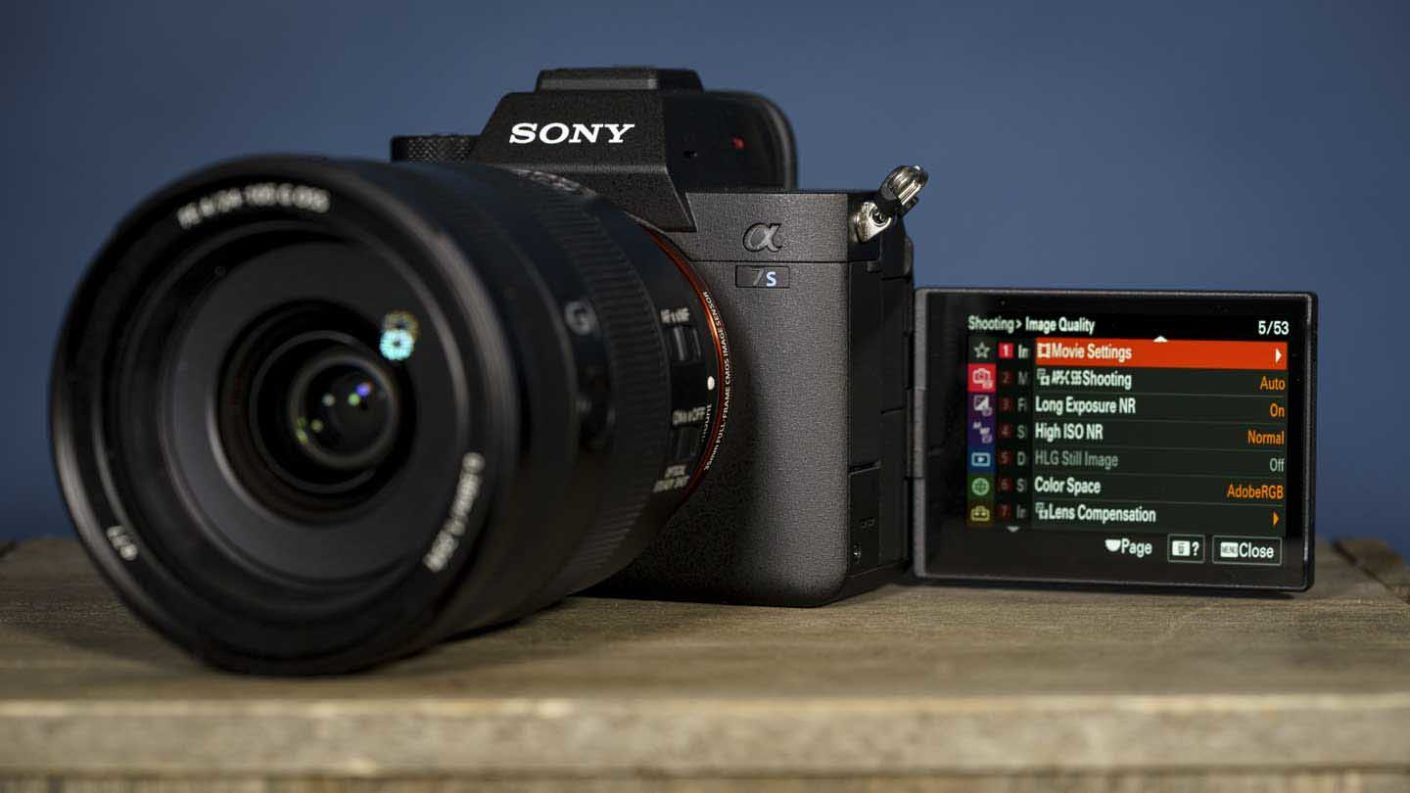
Specification
- Camera type: Full-frame mirrorless
- Announced: 28th July 2020
- Sensor: Full-frame 12.1Mp BSI CMOS
- Processing engine: Bionz XR
- Sensitivity: Video: ISO 80-102,400 expandable ISO 40-409,600. ISO base in S-Log is ISO 640 but it can be expanded down to ISO 160. Stills: ISO 80-102,400 expandable 40-409,600
- Autofocus system: Hybrid with 759 phase detection points and 425 contrast detection points, Real Time Eye AF (Human and Animal for stills, Human for video)
- Stabilisation: 5-axis IBIS and digital, up to 5.5EV shutter speed compensation
- Video resolution: 4K at up 120fps and 1080p at 240fps, 10-bit and 4:2:2 colour, 16-bit raw video over HDMI
- Video file formats: XAVC S,XAVC HS
- Video compression: XAVC S: MPEG-4 AVC/H.264, XAVC HS: MPEG-H HEVC/H.265
- 4K Video details: XAVC HS 4K 3840 x 2160 (4:2:0, 10bit, NTSC): 120p (200Mbps), 60p (150Mbps / 75Mbps / 45Mbps), 24p (100Mbps / 50Mbps / 30Mbps); 3840 x 2160 (4:2:0, 10bit, PAL): 100p (200Mbps), 50p (150Mbps / 75Mbps / 45Mbps); 3840 x 2160 (4:2:2, 10bit, NTSC): 120p (280Mbps), 60p (200Mbps / 100Mbps), 24p (100Mbps / 50Mbps); 3840 x 2160 (4:2:2, 10bit, PAL): 100p (280Mbps), 50p (200Mbps / 100Mbps) XAVC S 4K 3840 x 2160 (4:2:0, 8bit, NTSC): 120p (200Mbps), 60p (150Mbps), 30p (100Mbps / 60Mbps), 24p (100Mbps / 60Mbps); 3840 x 2160 (4:2:0, 8bit, PAL): 100p (200Mbps), 50p (150Mbps), 25p (100Mbps / 60Mbps); 3840 x 2160 (4:2:2, 10bit, NTSC): 120p (280Mbps), 60p (200Mbps), 30p (140Mbps), 24p (100Mbps); 3840 x 2160 (4:2:2, 10bit, PAL): 100p (280Mbps), 50p (200Mbps), 25p (140Mbps) XAVC S-I 4K 3840 x 2160 (4:2:2, 10bit, NTSC) (Approx.): 60p (600Mbps), 30p (300Mbps), 24p (240Mbps); 3840 x 2160 (4:2:2, 10bit, PAL): 50p (500Mbps), 25p (250Mbps)
- Gamut: S-Log2 and S-Log3, S-Gamut3.Cine and S-Gamut3
- Slow and Quick (S&Q) mode options: NTSC: 1fps,2fps,4fps,8fps,15fps,30fps,60fps,120fps, 240fps4, PAL: 1fps,2fps,3fps,6fps,12fps,25fps,50fps,100fps, 200fps
- Still File formats: Raw, JPG, HEIF
- Screen: 3-inch 1,440,000-dot vari-angle touchscreen
- Viewfinder: 0.64-inch type 9,437,184-dot OLED electronic viewfinder, with refresh rate up to 120fps, adjustable magnification up to 0.9x
- Maximum continuous shooting rate: 10fps with mechanical or electronic shutter for up to 1000 uncompressed raw files when a CFexpress Type 1 card is used
- Storage: Dual: SD/SDHC/SDXC (UHS-II) and CFexpress Type A
- Dimensions (W x H x D): 128.9 x 96.9 x 80.8mm / 5 1/8 x 3 7/8 x 3 1/4 inches
- Weight: 699g / 1 lb 8.7 oz
The headline video feature of the Sony a 7S III is that it can shoot 4K video at up to 120p and full HD footage at up to 240p, with full-sensor readout no pixel-binning and with the hybrid autofocus system in action.
There’s also 10-bit colour depth and 4:2:2 colour sampling available in all recording formats.
Sony has introduced new XAVC S-I 4K (All-Intra) and XAVC HS 4K (Long GOP) video formats and improved the XAVC S 4K (Long GOP) format for the A7S III.
Intra-frame recording is a compression procedure that captures more data but requires higher bit rates and therefore more uses storage capacity than Long GOP. It’s useful when you need the best quality 4K video recorded internally.
XAVC S-I 4K (All-I) can be used in normal recording at 50/25fps and 10bit 4:2:2 500Mbps and in S&Q (Slow and Quick) mode at 110/50/25/12/6/3/2/1fps at 25p (4x slow-mo)/50p and 10bit 4:2:2 250Mbps. It’s the S&Q options that make using a CFexpress card essential.
The bit rate in S&Q mode is 250Mbps which means the recorded bitrate/framerate is 10, much higher than in previous cameras. As a result, the in-camera slow and quick motion results should be much better than in the past.
After the 8K-capabilities of the Canon EOS R5, the Sony A7S III might seem a bit of an anti-climax. Some videographers were probably hoping for a big jump in resolution from the 12mp A7S II. However, Sony already has the 61Mp A7R IV and the 24Mp A7 III, so sticking with 12Mp means that the A7S III has even better low-light capability than its predecessor but with a much better autofocus system, a vari-angle screen and the highest-resolution viewfinder around. The A7S III is about more than grabbing the headlines for its resolution, it promises to make capturing 4K video easier than before and for that video quality to be the best 4K footage you can get from a Sony camera. It doesn’t disappoint as the quality of the footage is superb.
£3800
€4200 / $3499For
- Large pixels for great low-light performance
- 4K full-pixel readout without binning and 10-bit depth 4:2:2 colour available in all recording formats
- Vari-angle touchscreen and class-leading electronic viewfinder
Panasonic GH5
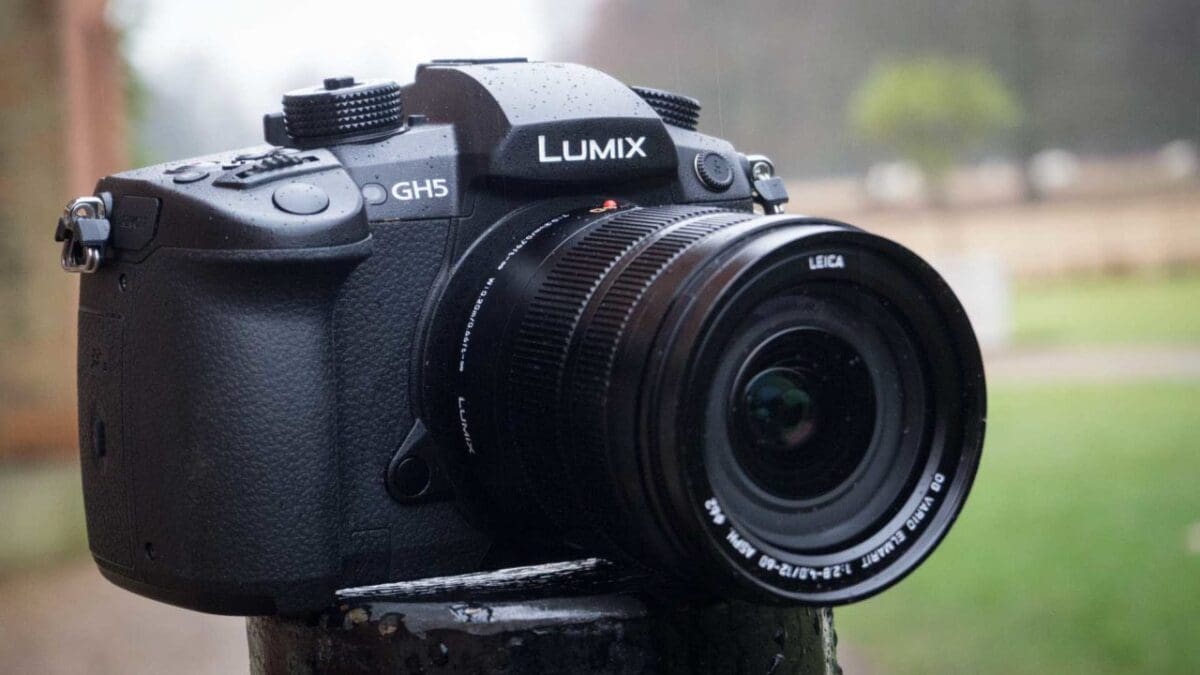
Videographers will be pleased to learn that there’s unlimited 4K video recording – most cameras can only record in bursts of up to 29minutes and 59 seconds. There’s also a choice between MOV, MP4, AVCHD Progressive and AVCHD formats at a variety of frame rates, the system frequency can be set to 59.94Hz, 50.00Hz or 24.00Hz.
In addition, there’s a Waveform Monitor and Vector Scope to meet the needs of professional videographers. This embeds SMPTE-compliant Time Code with Rec Run or Free Run counting to aid with multiple device synchronisation.
It’s possible to shoot 4096 x 2160 4K at 24p (or 3840 x 2160 4K at 60p, 50p, 30p, 25p, 24p with no cropping), 4:2:2 10-bit Full HD (1080p) recording and 4K 4:2:2 10-bit ALL-Intra MP4/MOV (apart from at 60/50p) and Full HD 4:2:2 10-bit ALL-Intra recording. The step-up from 8-bit to 10-bit recording vastly increases the range of colours that can be recorded.
A firmware update has also added high-resolution Anamorphic Video Mode and Hybrid Log Gamma for 4K HDR Video (for playback on HDR compatible televisions).
It’s also possible to add V-LogL recording via an optional software key (DMW-SFU1), with LUT (Look Up Table) and V-LogL View Assist to help experienced videographers get the colour and contrast they want.
Further good news for video shooters is that the GH5 can output live to an external recorder and simultaneous internal (there are dual SD card ports) and external recording is possible. Plus there’s an optional adaptor (DMW-XLR1) to allow an XLR microphone to be used for sound recording.
£1799
$1499For
- Extensive video specification
- High-quality stills and video
- High-quality EVF and vari-angle touch-screen
Sony A7 III
Specification
- Announced: 26th February 2018
- Camera type: Full-frame mirrorless
- Sensor: 24.2Mp Full frame (35.6×23.8mm), Exmor R CMOS sensor
- Processor: Bionz X
- Lens mount: Sony E
- Sensitivity range: Stills: ISO 100-51,200, expandable to 50-204,800, Video: ISO 100-51,200, expandable to 100-102,400
- Maximum continuous shooting rate: 10fps with full AF and metering
- Maximum video resolution: 4K (3840 x 2160)
- Autofocus system: Hybrid with 693 phase detection points and 425 contrast detection points
- Viewfinder: 0.5-inch OLED with 2,359,296 dots
- Screen: 3-inch 921,600-dot tilting touchscreen
- Storage: Dual Slot, Slot 1: SD (UHS-I/II), Slot 2: Multi slot for Memory Stick Duo/SD (UHS-I)
- Dimensions (W x H x D): 126.9 x 95.6 x 73.7mm
- Weight: 650g
The A7 III is capable of recording 4K (3840 x 2160) footage to a memory card at 30p/25p and 60Mbps or 100Mbsp. There’s also S-Log2 and S-Log3 available for recording flat footage ready for grading, and a Hybrid Log-Gamma (HLG) picture profile is provided for displaying video direct from the camera on HDR (HLG) compatible televisions.
When the camera is set to record 4K video it uses full pixel readout without pixel binning. This means it gathers around 2.4x as much data as is needed for 4K movies. It then oversamples the files to produce 4K footage with better depth and dynamic range.
There’s also a Zebra display, Gamma Display assist and proxy recording.
In addition, Full HD footage can be recorded at up to 120/100p (NTSC/PAL) for slow-motion playback.
£1699
$1999For
- Good-quality 24Mp full-frame sensor
- Excellent autofocus system
- Attractively priced in the full-frame market
Fujifilm X-H1
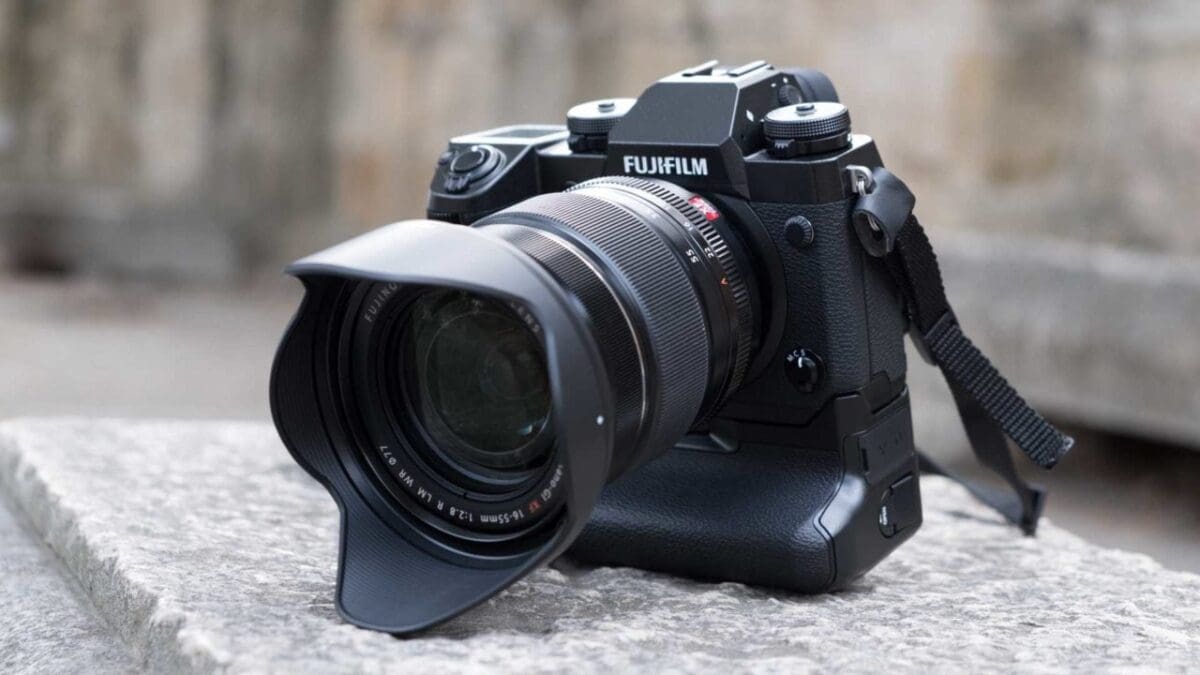
Specification
- Camera type: Mirrorless
- Sensor: 24.3Mp APS-C (23.6 x 15.6mm) X-Trans CMOS
- Processing engine: X Processor Pro
- Lens mount: Fujifilm X
- Sensitivity range: ISO 200-12,800 expandable to ISO 100-51,200
- Autofocus system: Hybrid with 91 or 325 points
- Max continuous shooting rate: Electronic shutter: 14fps for 42 jpegs, 28 lossless compressed raw or 25 uncompressed raw, Mechanical shutter: 8fps for 83 jpegs, 33 lossless compressed raw or 27 uncompressed raw or 11fps with VPB for 73 jpegs, 30 lossless compressed raw or 27 uncompressed raw
- Max video resolution: 4K (4096×2160)] 24P / 23.98P up to approx. 15min. 4K (3840×2160)] 29.97P / 25P / 24P / 23.98P up to approx. 15min. Full HD (1920×1080)] 59.94P / 50P / 29.97P / 25P / 24P / 23.98P up to approx. 20min. HD (1280×720)] 59.94P / 50P / 29.97P / 25P / 24P / 23.98P up to approx. 30min. With Vertical Power Booster Grip attached, individual movie recording time is extended up to approx. 30min. on both 4K and Full HD mode.
- Viewfinder: 0.5 inch 3.69 million-dot OLED Color Viewfinder with approx 100% coverage Eyepoint: approx. 23mm Diopter adjustment: -4~+2m-1 Magnification: 0.75× with 50mm lens
- Screen: Dual-tilting 3-inch LCD with 1,040,000 dots
- Dimensions: 139.8 x 97.3 x 85.5mm
- Weight: 623g (body only), 673g with battery and card
The headline video features of the X-H1 are its C4K (4096×2160) and 200Mbps shooting capability long with F-log recording that operates when the footage is saved to an SD-type memory card.
There’s also a new ‘Eterna‘ Film Simulation mode that is intended for use in movie mode. This calibrates the camera to output footage that resembles the appearance of cinematic film, reining-in the colour saturation and delivering rich shadows.
Footage is 8-bit and has 4:2:0 colour when recording to a memory card or 4:2:2 when recording to an external device.
Slow motion fans can shoot Full-HD footage at up to 120p.
The Dynamic Range setting for video can also be set to 400% and this is claimed to extend the range to 12EV.
An internal mic (24 bit/48 kHz) is provided but there’s a 3.5mm port to connect an external mic for sound recording. If you want to connect headphones, however, you’ll have to invest in the optional Vertical Power Boost grip VPB-XH1. This grip also extends the 4K video recording time to 30mins at a time.
Good news for multi-camera shooters is that the X-H1 has a Time Code option.
£1699
For
- C4K video with F-Log and 200Mbps
- 5-axis image stabilisation built-in
- Superb viewfinder
Nikon Z6 II
Specification
- Camera type: Full-frame mirrorless camera
- Announced: 14th October 2020
- Lens mount: Nikon Z
- Sensor: Full-frame (FX 35.9 x 23.9mm) 24.5MP backside illuminated (BSI) sensor
- Processing engine: Dual Expeed 6
- Stabilisation: 5-axis in-body VR
- Sensitivity: ISO 100-51,200, expandable to ISO 50-204,800
- Maximum continuous shooting rate: 14fps for up to 200Jpegs or 124 12-bit uncompressed raw files
- Autofocus system: Hybrid with phase and contrast detection
- Phase detection points: 273
- Video resolution: 4K (3840 x 2160) 30/25/24p (60P to come with free firmware update in Feb 2021), Full-HD (1920 x 1080) 120/100/60/50/30/25/24p, Slow-motion mode 1920 x 1080 30p x4/25p x4/24p x5
- Viewfinder: 0.5-inch 3.69-million-dot electronic viewfinder
- Screen: 3.2-inch 2,100,000-dot tilting touch-screen
- Storage: Dual slot 1 XQD/CFexpress and 1 SD/SDHC/SDXC
- Dimensions (W x H x D): 134 x 100.5 x 69.5mm / 5.3 x 4 x 2.8-inches
- Weight: 705g with battery and memory card but without body cap, 615g body only
Like the Z6, the Nikon Z6 II can record 4K UHD (3840 × 2160) video at 30P, and 60P will be added with a firmware update that expected to arrive in February 2021. However, disappointingly, this 60p capability will be subject to a 1.5x crop factor which means a focal length of 24mm, for example, will seem like 36mm.
It’s also possible to record Full HD footage at up to 120p for slow-motion playback.
Footage recorded internally is in 8bit colour. However, if you connect an external recorder via the HDMI connection, the Z6II can record 10bit 4:2:2 colour with N-Log for better grading and colour matching.
The Z6II also features Timecode, focus peaking and zebra display, plus the focusing speed and tracking sensitivity can be adjusted to suit the subject or the desired look of the movie.
The big news on the video-front is that the Z6II has eye detection focusing for humans and animals. That should make producing good-quality video easier for many people.
£1999
€2262For
- High-quality sensor
- Excellent user interface and control layout
- Weatherproof build
Nikon Z7 II
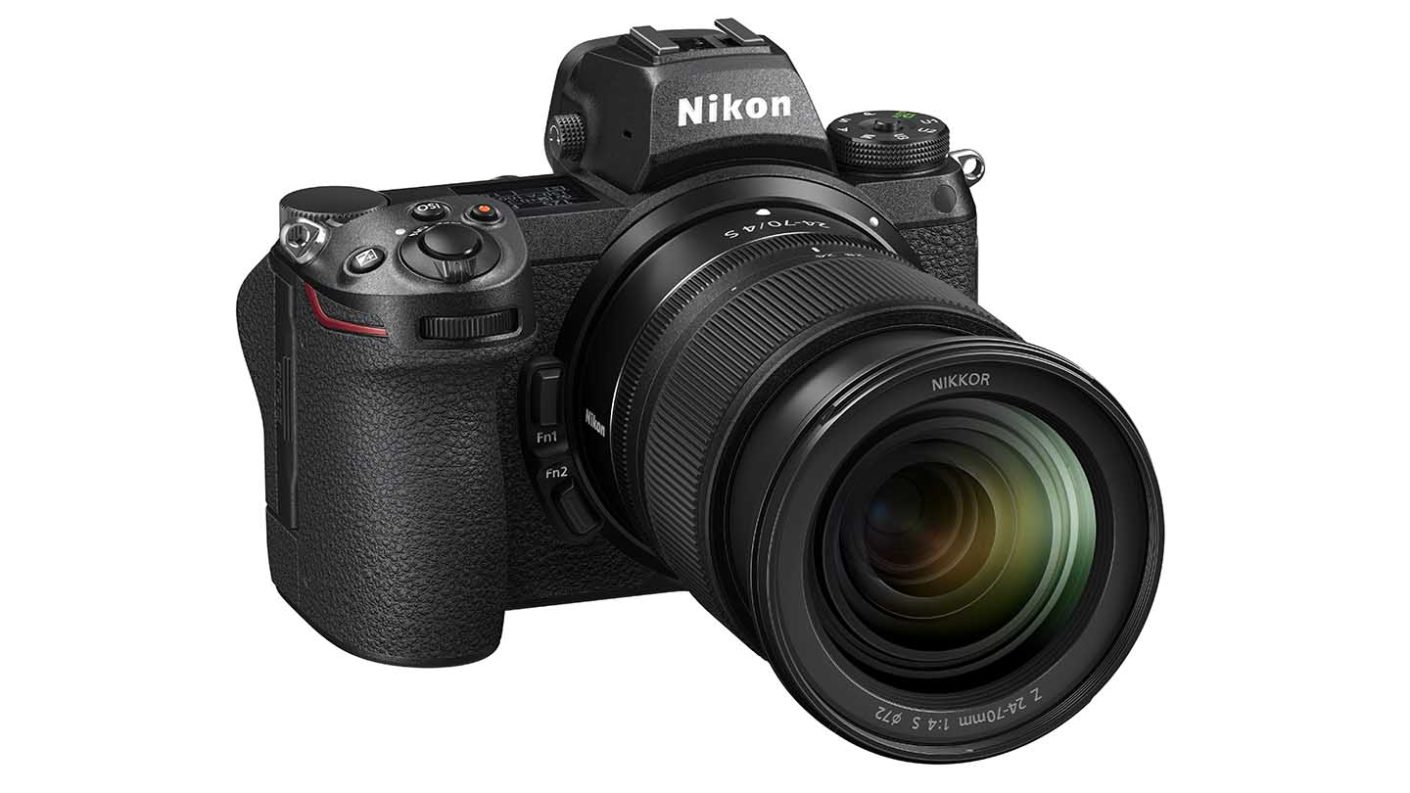
Specification
- Camera type: Full-frame mirrorless camera
- Announced: 14th October 2020
- Lens mount: Nikon Z
- Sensor: Full-frame (FX 35.9 x 23.9mm) 45.7MP backside illuminated (BSI) sensor
- Processing engine: Dual Expeed 6
- Stabilisation: 5-axis in-body VR
- Sensitivity: ISO 64-25,600, expandable to ISO 32-102,400
- Maximum continuous shooting rate: 10fps for up to 200Jpegs or 77 12-bit uncompressed raw files, 9fps with 14-bit raw files
- Autofocus system: Hybrid with phase and contrast detection
- Phase detection points: 493
- Video resolution: 4K (3840 x 2160) 60/50/30/25/24p, Full-HD (1920 x 1080) 120/100/60/50/30/25/24p, Slow-motion mode 1920 x 1080 30p x4/25p x4/24p
- Viewfinder: 0.5-inch 3.69-million-dot electronic viewfinder
- Screen: 3.2-inch 2,100,000-dot tilting touch-screen
- Storage: Dual slot 1 XQD/CFexpress and 1 SD/SDHC/SDXC
- Dimensions (W x H x D): 134 x 100.5 x 69.5mm / 5.3 x 4 x 2.8-inches
- Weight: 705g with battery and memory card but without body cap, 615g body only
Like the Z7, the Nikon Z7II can record 4K UHD (3840 x 2160) video. However, the maximum frame rate is boosted from 30P to 60P, which is great news for slow-motion fans.
As before, it’s also possible to shoot Full HD video at up to 120p.
If you record to a memory card in the Z7II, the video is 8-Bit, but connecting an external storage device via the HDMI port enables the video quality to be increased to 10-bit 4:2:2 with (or without) N-Log.
N-Log is useful if you want to grade your footage post-capture, or if you need to match the footage to that from another camera. Handily, timecode is available to help with editing video from multiple cameras.
With a compatible Atomos recorder connected, the Z7II can record video as Apple ProRes Raw which means you get the full benefit of the camera’s data gathering potential. However, this feature needs to be unlocked by a Nikon service centre at a cost of £179/$199.
Focus peaking and zebra display are also available to help with nailing the focus and exposure.
The Z7II can also shoot timelapse movies.
£2999
€3442 / $2996.95For
- High-quality sensor
- Excellent user interface and control layout
- Weatherproof build
Nikon D850
Specification
- Camera type: Full-frame (FX) DSLR
- Announced: 24th August 2017
- Lens mount: Nikon F
- Sensor: 45.7Mp full-frame (35.9 x 23.9mm) backside-illuminated CMOS
- Maximum continuous shooting rate: 7fps as standard, 9fps with the optional MB-D18 Multi-Power Battery Pack for up to 51 14-bit lossless compressed raw files or 170 12-bit lossless compressed raw files
- Autofocus system: Viewfinder: Multi-CAM 20K autofocus sensor 153 focus points (including 99 cross-type sensors and 15 sensors that support f/8), of which 55 (35 cross-type sensors and 9 f/8 sensors) are available for selection, Live view: Contrast detection
- Viewfinder: Optical pentaprism type
- Screen: Tilting, touch-sensitive 3.2-inch TFT LCD with 2,359,000 dots
- Dimensions: 146×124×78.5mm / 5.8×4.9×3.1inches
- Weight: 1,005g / 2lb 3.5oz with battery and XQD memory card but without body cap, 915g /2lb 0.3oz camera body only
Aiming to benefit from Nikon’s wide-angle lenses, the D850 is capable of producing 4K/UHD (3,840 x 2160) video at 30, 25 or 24p with no cropping. Alternatively, Full HD (1920 x 1080) video can be recorded at 60, 50, 30, 25 or 24p. In addition, there’s a 4x / 5x slow-motion Full HD movie option.
As well as recording video to a card in the camera, it’s possible to simultaneously record uncompressed 4:2:2 8-bit 4K files onto an external drive via an HDMI connection.
Video can be saved in MP4 or MOV format.
The inclusion of an intervalometer enables the creation of 4K time lapse movies in-camera. In addition, stills can be shot to create 8K time lapse movies but the video has to be created using a computer rather than in-camera.
Nikon has stuck with a contrast detection autofocus system for Live View and Video mode. In addition to Normal-area AF (single point), Wide-area, Pin-point, Face Detection and Subject tracking AF modes are available.
£3500
$3296.95Olympus OM-D E-M1 Mark III
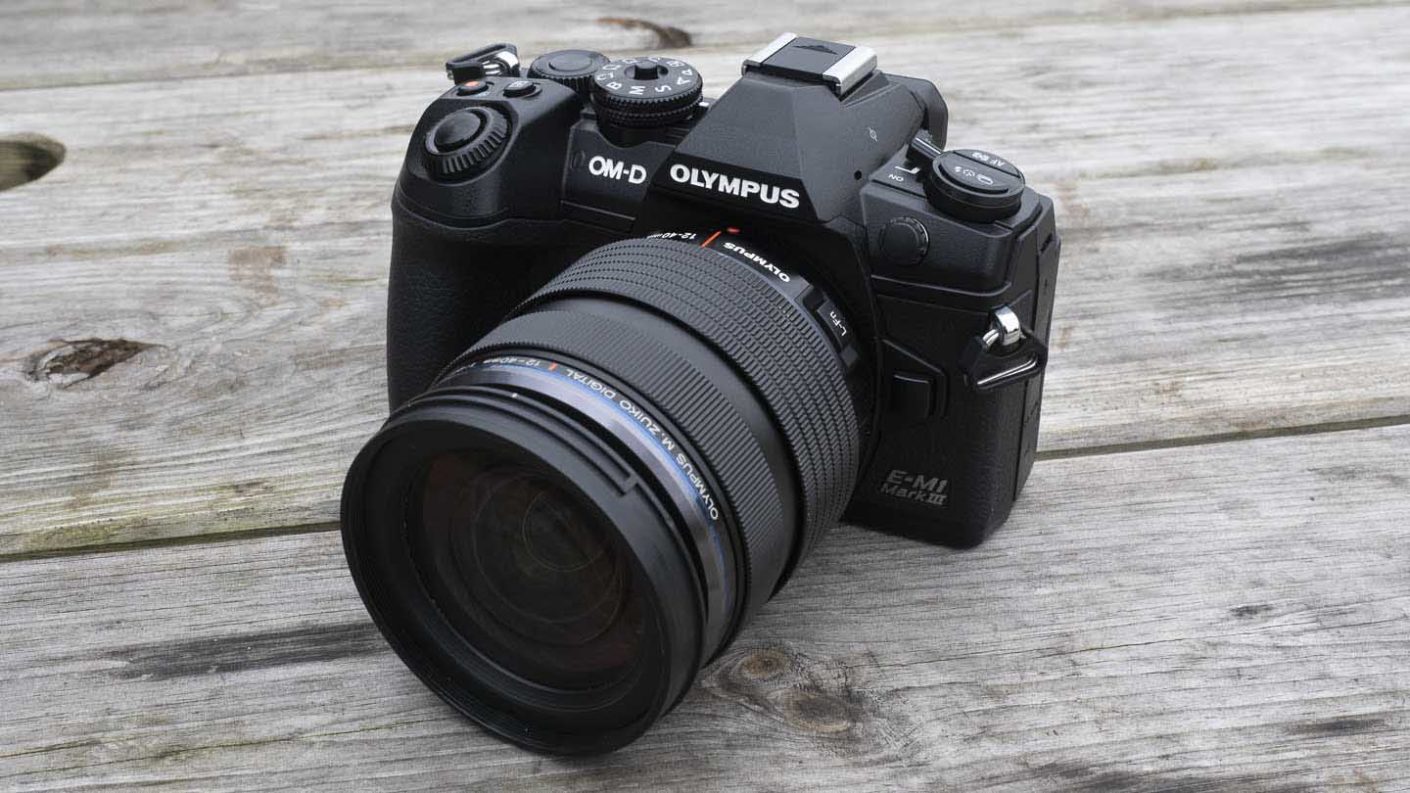
Specification
- Camera type: Mirrorless
- Lens mount: Micro Four Thirds
- Sensor: Four Thirds type 20.4 MP Live MOS sensor
- Announced: 12th February 2020
- Processing engine: TruePic IX
- Autofocus system: Hybrid with 121-point all cross-type focus points
- Max continuous shooting rate: 18fps AF/AE mechanical shutter (C-AF), 60fps in electronic shutter (S-AF)
- Max video resolution: C4K (4096 x 2160) at 30/25p
- Viewfinder: 2,360,000-dot electronic viewfinder
- Sensitivity range: ISO 64-25,600
- Screen: Vari‑angle 3-inch 1,037,000-dot touchscreen
- Storage: 2x SD/SDHC/SDXC (1 UHS-I and 1 UHS-II)
- Dimensions (LxHxW): 134.1 x 90.9 x 68.9mm
- Weight: 504g body only, 580g with battery and SD card
Olympus isn’t quite as synonymous with video as its Micro Four Thirds counterpart Panasonic, but it has quietly offered some awesome video options in the OM-D E-M1 Mark III that might appeal to mostly stills photographers looking to shoot more videography.
For starters, the Olympus OM-D E-M1 III can shoot C4K video at 25/30p in OM-Log400 mode. OM-Log400 was introduced with the E-M1X and it sets the camera to record very low contrast footage to capture greater shadow and highlight detail. It gives more flexibility manipulate the contrast and colour post-capture.
Helpfully, there’s also a View Assist function that previews the footage in Full HD standard BT.709 equivalent to make it easier to assess what is being captured in OM-Log400 mode.
It’s also possible to record Full HD video at a range of frame rates, topping out at 120fps, which is great for slow motion playback.
In addition, there’s a video-specific stabilisation mode that uses electronic stabilisation combined with in-body 5-axis stabilisation.
Further good news is that the E-M1 Mark III includes a feature that was surprisingly absent from the Mark II, the ability for the sensitivity (ISO) to be set automatically when shooting video. There’s also a port to connect an HDMI monitor and a mic port for better audio quality.
£1600
$1499For
- Compact size with vari-angle screen
- Great feature set
- Excellent lens range
Panasonic GH5S
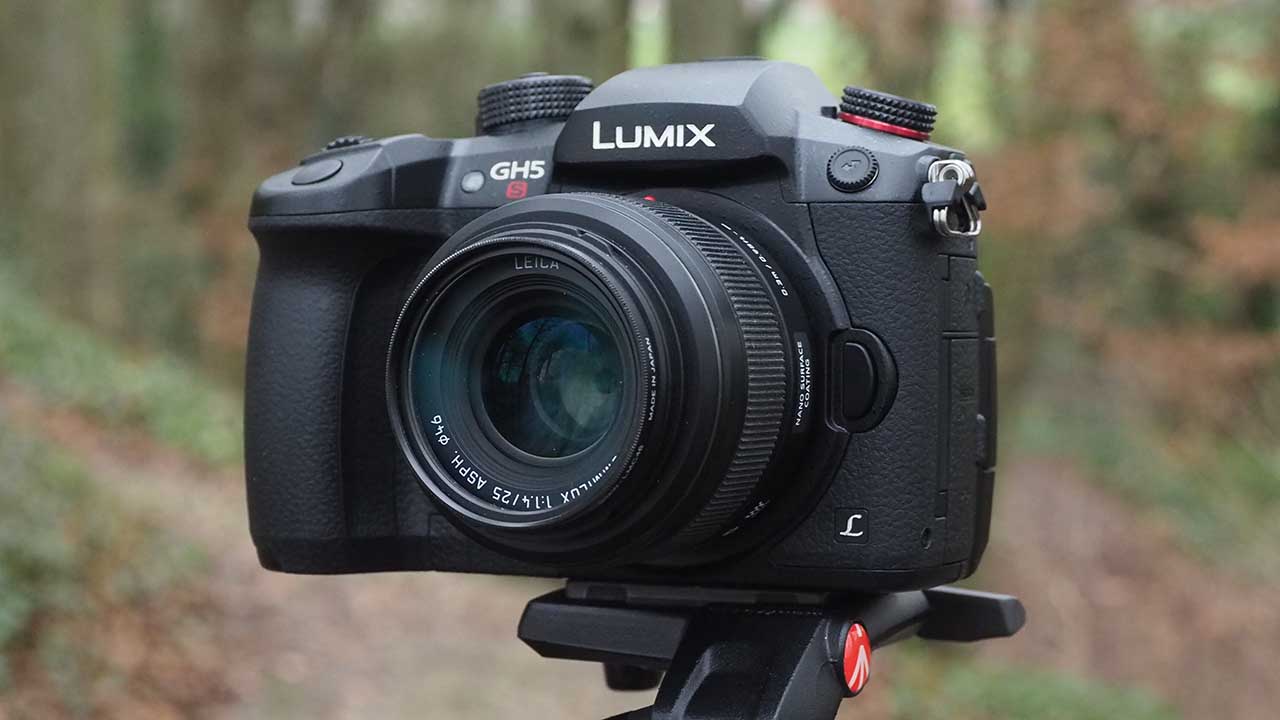
Specification
- Sensor: 10.28MP Multi Aspect Ratio MOS Sensor
- Video: DCI 4K60p and Full HD 1080/240p Video
- Log Mode: V-Log L Gamma and HDR Hybrid Log Gamma
- Video Quality: Internal 4:2:2 10-Bit Long GOP
- Viewfinder: 0.76x 3.68m-Dot OLED Viewfinder
- Sensitivity: Dual Native ISO 400 and ISO 2500
- Touchscreen: 3.2" 1.62m-Dot Free-Angle Touchscreen
- Memory & Connectivity: Dual UHS-II SD Slots; Wi-Fi & Bluetooth
- Stills: 12-fps Cont. Shooting and 4K PHOTO Modes
Like the GH5, the GH5S can shoot Cinema 4K (4096 x 2160) footage. However, whereas the GH5 is limited to 24p at this resolution, the GH5S can shoot at 60p, 50p, 30p, 25p or 24p. Furthermore, if you opt for 30p, 25p or 24p, you can shoot that C4K footage in 4:2:2 10-bit for a greater range of colours and smoother tonal gradations.
If high bitrates are important, the GH5S can record 4:2:2 10-bit 400-Mbps All-Intra in 4K 30p, 25p or 24p and C4K 24p. While C4K and 4K footage can be recorded at up to 60fps, Full-HD (1920 x 1080) footage can be recorded at up to 240fps, giving 10x slow motion playback.
Panasonic made V-Log L available as an optional, paid-for download for the GH5, with the GH5S it comes pre-installed. In addition, there’s Hybrid Log Gamma (HLG) mode available in the Photo Style options for 4K HDR video compliance.
Further good news is that video recording is only limited by the battery life and memory card capacity.
In a new move for a Panasonic G-series camera, each pixel on the GH5S sensor has two analogue circuits and this enables two base sensitivities (ISO 400 and ISO 2500). This Dual Native ISO Technology and the lower pixel count of the GH5S are designed to improve dynamic range and help keep noise in check even in very low light when sensitivity (ISO) is high.
As the GH5S’s sensor is a little larger than a standard Four Thirds type sensor and has a multi-aspect ratio design, it’s possible to maintain a constant diagonal field of view while video or image aspect ratio is changed from 4:3, 17:9, 16:9 and 3:2.
Finally, while it’s primarily a video camera, the GH5S can shoot stills and can record 14-bit raw files for greater data capture and file flexibility.
£1829
$1997.99For
- Impressive video specification
- Timecode IN/OUT
- V-Log L pre-installed
Canon EOS R5
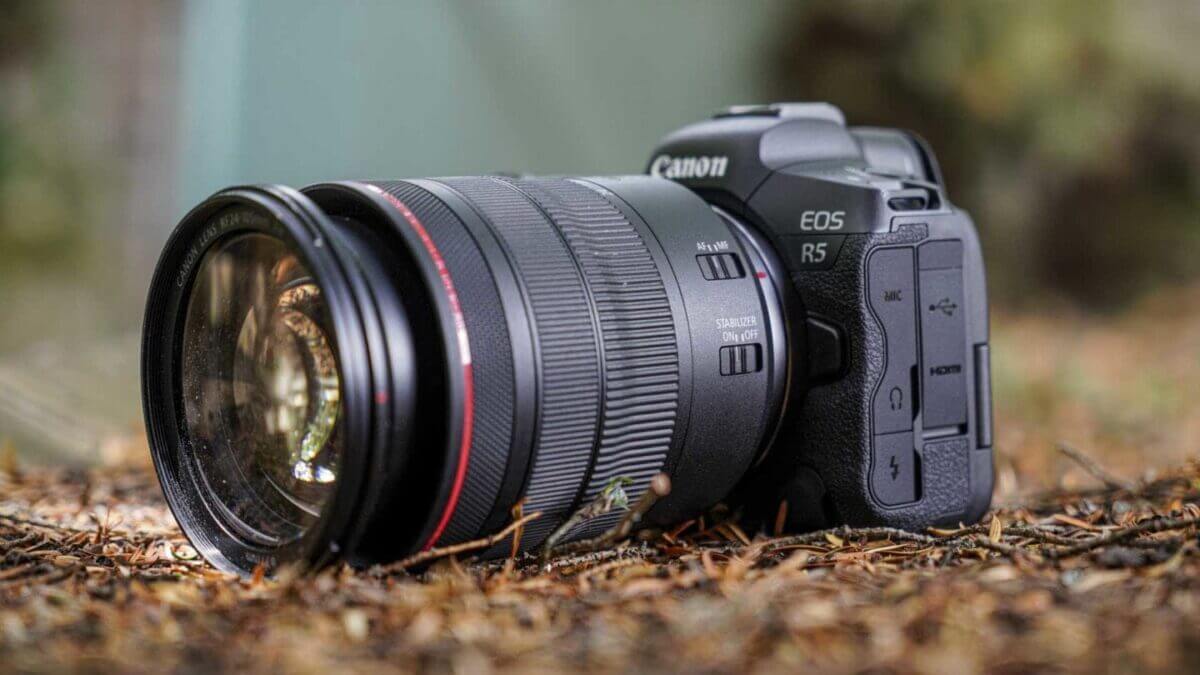
Specification
- Camera Type: Mirrorless
- Announced: 9th July 2020
- Sensor: 45Mp Full-frame Dual Pixel CMOS AF II
- Processor: Digic X
- Lens mount: RF
- Sensitivity range: Stills: ISO 100-51,200 expandable to ISO 50-102,400, Movies: ISO 100-25600, expandable to ISO ISO 51,200
- Metering: 384-zone metering with Evaluative metering (linked to All AF points), Partial metering (approx. 6.1% of viewfinder at centre), Spot metering: Centre spot metering (approx. 3.1% viewfinder at centre), Centre weighted average metering
- Shutter speed range: 1/8000sec-30 seconds and Bulb
- File formats: Raw + Jpeg/HEIF, MP4
- Maximum continuous shooting rate: Mechanical shutter: 12fps, Electronic shutter: 20fps
- Maximum video resolution: Uncropped, internal raw recording 8K video at up to 29.97fps in 4:2:2 10-bit in Canon Log (H.265) or 4:2:2 10-bit HDR PQ (H.265), Uncropped internal recording 4K video at up to 119.88fps in 4:2:2 10-bit in Canon Log (H.265) or 4:2:2 10-bit HDR PQ (H.265) 4:2:2 10-bit in Canon Log or 4:2:2 10-bit HDR PQ, 4K output over HDMI at up to 59.94fps
- Autofocus system: Dual Pixel CMOS AF II phase detection with 5940 points in stills and 4500 points in movie mode
- Viewfinder: 0.5-inch 5.76million-dot OLED electronic viewfinder with 120fps display and 0.76x magnification
- Screen: 3.15-inch 2.1-million dot vari-angle touchscreen
- Autofocus: Dual Pixel CMOS AF II with Advanced Animal AF (recognising dogs, cats and birds) supported in all video modes with 100% coverage and up to 1053 'AF segments'
- Stabilisation: In-body image stabilisation (IBIS) that works with lens IS and enables up to 8-stops of shutter speed compensation
- Storage: Dual slots, 1x CFexpress, 1x SDXC UHS-II
- Dimensions: 135.8 x 97.5 x 88mm
- Weight: 650 g / 738 g with card and battery
For video, the main headline for the Canon R5 is that it can shoot raw 8K 12-bit video at up to 29.97fps. It’s also possible to shoot in 4:2:2 10-bit in Canon Log (H.265) or 4:2:2 10-bit HDR PQ (H.265).
In lay terms, an 8K video frame is equivalent to a 35Mp image and shooting in 4:2:2 10-bit with Canon Log means there should be plenty of scope for adjusting/grading footage post-capture. It also means that the EOS R5 can be used alongside other cameras, including Canon’s cine range, and the footage can be made to match.
Alternatively, 4K video can be recorded at up to 119.88fps in 4:2:2 10-bit in Canon Log (H.265) or 4:2:2 10-bit HDR PQ (H.265) 4:2:2 10-bit in Canon Log or 4:2:2 10-bit HDR PQ. That should be great news for slow motion video fans.
If you prefer to record 4K video to an external storage device, there’s an HDMI connection that can cope with recording at up to 59.94fps.
The Canon R5 also has an HQ (high quality) mode that can be activated for 4K recording. This sets the camera to use the 8K technology and downsample the output to 4K.
£4199
$3899For
- 45Mp full-frame sensor with full AF coverage
- 12fps/20fps continuous shooting with continuous AF
- Uncropped internal 8K video recording for up to 20 minutes
Canon EOS R6
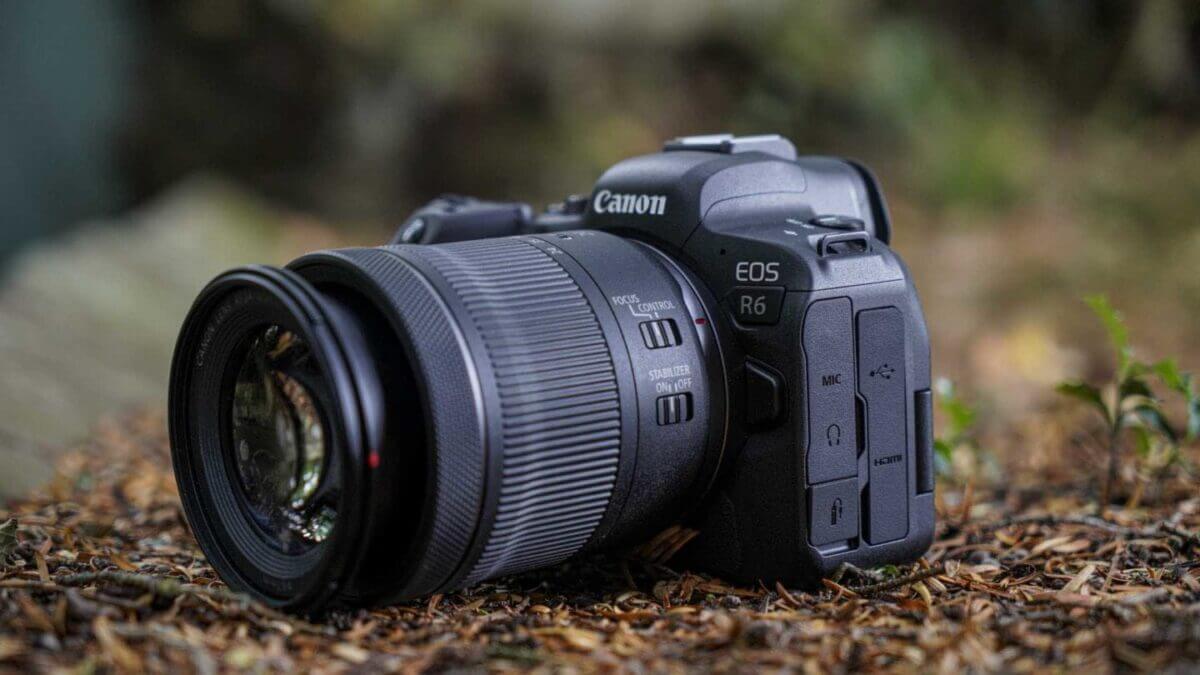
Specification
- Camera Type: Mirrorless
- Announced: 9th July 2020
- Sensor: 20Mp Full-frame Dual Pixel CMOS AF II
- Processor: Digic X
- Lens mount: RF
- Sensitivity range: Stills: ISO 100-102,400 expandable to ISO 50-204,800, Movies: ISO 100-6,400, expandable to ISO 204,800
- File formats: Raw + Jpeg/HEIF, MP4
- Maximum continuous shooting rate: Mechanical shutter: 12fps, Electronic shutter: 20fps
- Maximum video resolution: 4K video at up to 60fps, Full HD at up to 120fps. 4K video crop: 1.07x at 25p (1.19x with the Digital IS on), 1.52x at 60p
- Autofocus system: Dual Pixel CMOS AF II phase detection with 6,072 points in stills and 4968 points in movie mode
- Viewfinder: 0.5-inch 3.69million-dot OLED electronic viewfinder with 120fps refresh rate
- Screen: 3-inch 1.62-million dot vari-angle touchscreen
- Autofocus: Dual Pixel CMOS AF II with Advanced Animal AF (recognising dogs, cats and birds) supported in all video modes with 100% coverage and up to 1053 'AF segments'
- Stabilisation: In-body image stabilisation (IBIS) that works with lens IS and enables up to 8-stops of shutter speed compensation
- Storage: Dual slots, 2x SDXC UHS-II
- Dimensions: 138.4 x 97.5 x 88.4mm
- Weight: 598g / 680 g with card and battery
Although it doesn’t have the class-leading video resolution of the Canon R5, the Canon EOS R6 is no slouch when it comes to video credentials.
It can record 4K (3840 x 2160) video at up to 59.94fps, however, there is a slight crop (1.07x) as only 94% of the horizontal area of the sensor is used. This 4K video is produced by oversampling from 5.1K for better quality.
If you shoot 4K video at 60p, the crop gets a bit tighter at 1.52x.
There’s also a 4K movie cropping mode available that uses 62% of the horizontal area, which means there’s much greater cropping.
If you want to add drama to action shots, Full HD footage can be shot at up to 119.88fps for slow-motion playback.
It’s possible to record the highest resolution video to an SD UHS-II card in 8-bit H.264 or 10-bit 4:2:2 H.265 and Canon Log is available for greater post-capture gradability.
Incredibly, this is the first time that Canon has enabled a zebra display in an EOS camera. That’s a helpful guide for setting the exposure.
Other niceties include an HDMI micro port (Type D) for connecting an external monitor, a microphone port and a headphone socket.
£2500
€2899.99For
- Similar 20Mp full-frame sensor to the Canon EOS 1D X Mark III
- 12fps/20fps continuous shooting
- Superb autofocus system
Canon EOS 5D Mark IV
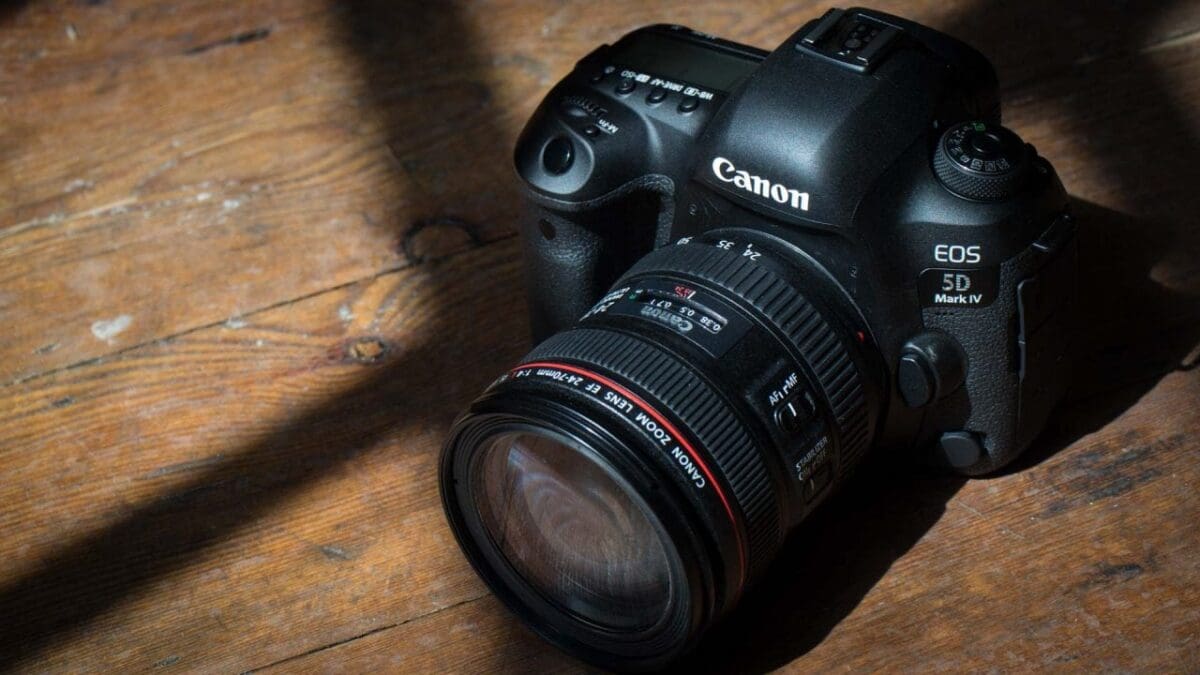
Specification
- Camera type: DSLR
- Announced: 25th August 2016
- Sensor: Full-frame (36 x 24mm) 30.4Mp CMOS
- Processor: Digic 6+
- Lens mount: Canon EF
- Autofocus system: Viewfinder: 61 points with a maximum of 41 cross-type points including 5 dual cross type at f/2.8 and 61 points with 21 cross-type points at f/8, Live View: Dial Pixel CMOS AF
- High-Speed Continuous Shooting Mode: 7fps
- Low-Speed Continuous Shooting Mode: 3fps
- Silent Continuous Shooting: Mirror raised slowly for less noise
- Maximum video resolution: 4K (17:9) 4096 x 2160 at 29.97, 25, 24, 23.98 fps
- Viewfinder: Pentaprism optical with 100% coverage
- Screen: 3.2-inch Clear View LCD II with 1,620,000 dots
- Storage: Dual: 1x CompactFlash and 1x SD/SDHC/SDXC
- Dimensions: 150.7 x 116.4 x 75.9mm
- Weight: 800g
Canon’s 5D Mark III and Mark II cameras have played an important role in the evolution of video shooting and the Mark IV continues this development by adding 4K recording capability. Like the Canon 1DX Mark II, but unlike many other cameras, we’re talking ‘true’ 4K (4096 x 2160) video at 30fps and in 4:2:2 (8 bit) here.
However, this is for internal recording only. It’s also possible to shoot Full HD video at up to 60fps and 720p video at 120fps, widening the scope for slow motion playback. Full HD footage can be recorded externally via HDMI.
Disappointingly, there’s no video-specific Picture Style to produce flat footage that designed for grading.
Instead, users must choose between Auto, Standard, Portrait, Landscape, Fine Detail, Neutral, Faithful or Monochrome. Alternatively, it’s possible to create three custom styles and there’s an HDR movie setting.
£1799
$2499For
- 30Mp full-frame sensor
- ISO 100-32000 (expands to 50-102400)
Panasonic Lumix S5
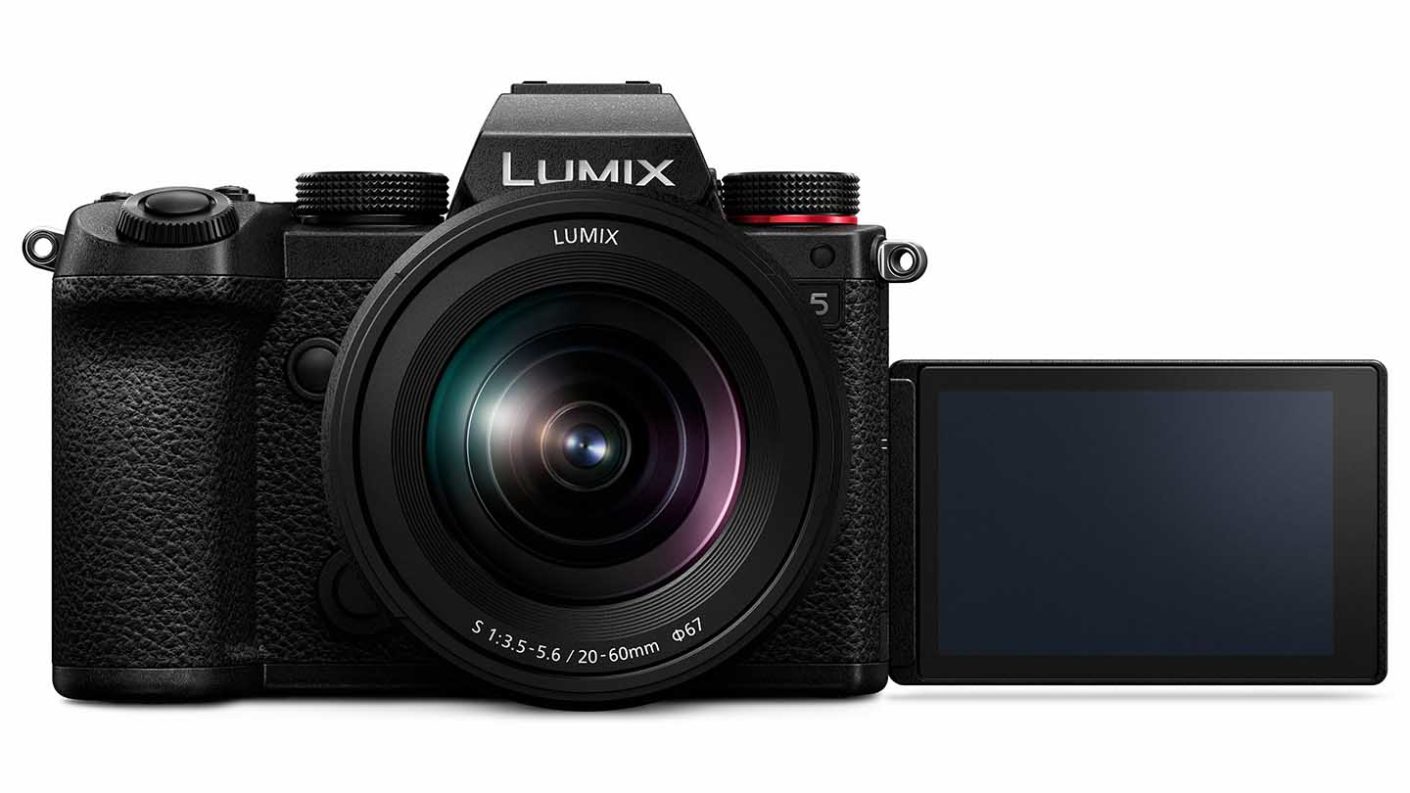
Specification
- Camera type: Mirrorless
- Announced: 2nd September 2020
- Sensor: 24.2Mp full-frame (35.6 x 23.8mm) CMOS sensor
- Lens mount: L
- Construction: Magnesium alloy with dust and splash resistant seals
- Stabilisation: 5 axis in-body IS to 5EV, 6.5 with Dual IS
- Screen: 3-inch 1,840,000-dot vari-angle touchscreen
- Viewfinder: 2,360,000-dot OLED electronic viewfinder with 0.74x magnification
- Key video specifications: 4K (3840x2160) 4:2:2 10-bit LongGOP H.264 29.97/23.98p/25p and 150Mbps for up to 30mins, 4K (3840x2160) 4:2:0 8-bit LongGOP H.264 29.97/23.98p/25p and 100Mbps unlimited, Full HD (1920x1080) 4:2:2 10-bit LongGOP H.264 59.94/29.97/23.98p/50/25p and 100Mbps unlimited
- Slow & Quick motion: Slow: 4K up to 60p in MP4, FHD up to 120p at full width or 180p with narrower angle of view, Quick: 4K to 1p
- Sensitivity: Dual native ISO 100, 6400, Range: ISO100-51,200, expandable to ISO 50-204,800. Dual-native ISO for video
- Shutter speed: 60-1/16,000sec, Bulb to 30mins
- Maximum continuous shooting rate: AF-S or manual focus: 7fps, AF-C: 5fps, 6K Photo 30fps, 4K Photo: 60fps
- Memory: Dual SD card slots, 1 UHS-II, 1 UHS-I
- Weight: 714g with memory card and battery
- Dimensions (WxHxD): 132.6x97.1x81.9mm
Panasonic is pitching the S5 at people who have started out as photographers and content creators who want to create more video. Its headline video specification is that it can shoot 4K (3840×2160) footage in 4:2:2 and 10-bit LongGOP H.264 at 29.97/23.98p/25p. That’s when recording internally to an SD-type card.
It can shoot and that quality and resolution for up to 30minutes. Alternatively, if you’re happy to 4:2:0 8-bit 4K footage, you can shoot indefinitely until your memory cards are full.
If the Panasonic S5’s HMDI port is used to connect external storage, it’s possible to record 4K 4:2:2 10-bit footage at 60p. That means you can have high resolution 2x slow-motion video in 4K resolution.
There are also ports to connect an external microphone and headphones.
Panasonic is at pains to point out that its standard testing procedures ensure that it is possible to shoot 4K video at 40-degrees centigrade and that the S5 won’t overheat in regular, professional use. It doesn’t have a fan built-in like the S1H, but the S5 has a heat-dispersing design.
Further good news is that V-Log is pre-installed and there’s no extra charge to record more grade-ready video. There’s also a selection of other picture profiles including the natural-looking ‘Like 709’.
In addition, the Panasonic S5 can shoot anamorphic video (with APS-C crop) to create the popular cinematic look.
£1799
$1998For
- Smaller than the MFT Lumix GH5
- Viewfinder and vari-angle touchscreen
- V-log pre-installed

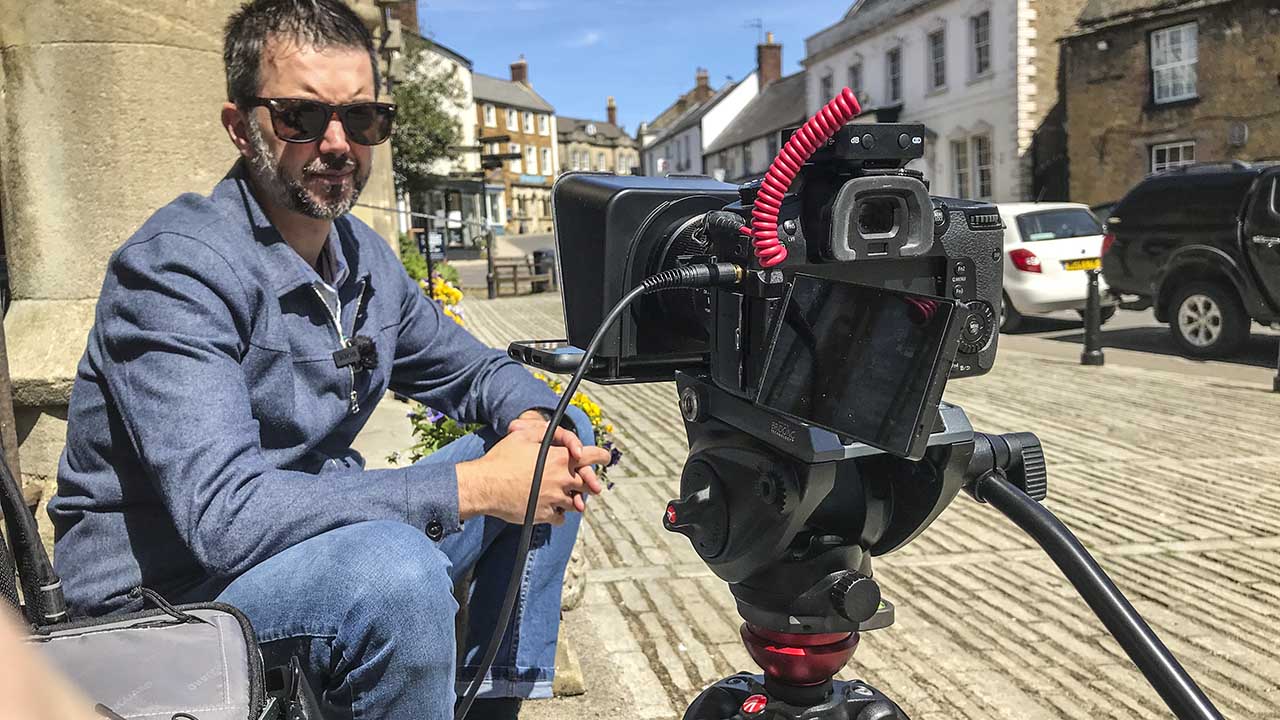
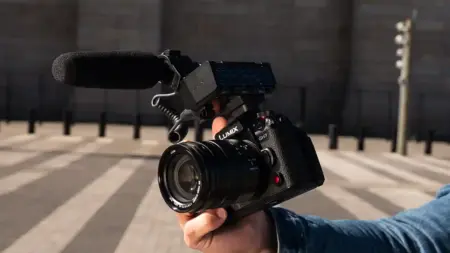
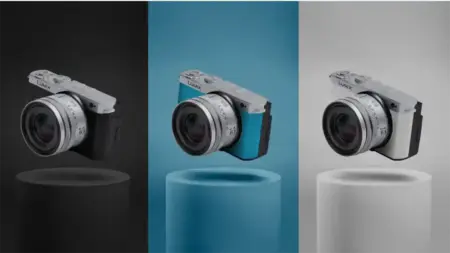
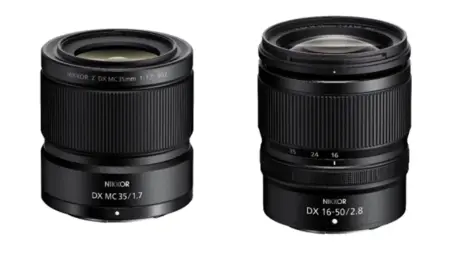
Leave a Reply
You must be logged in to post a comment.